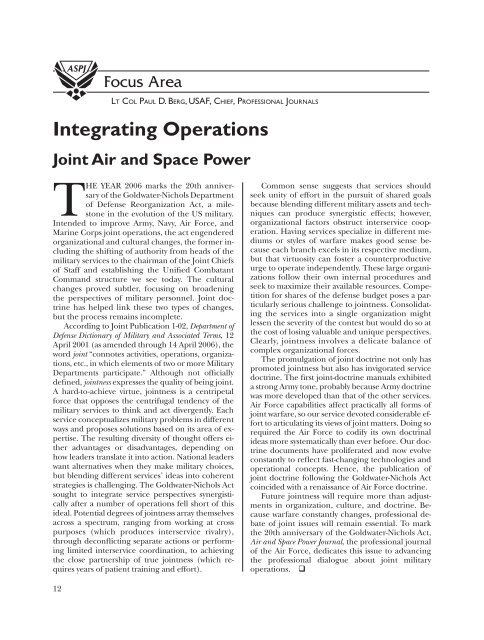Fall 2006 - Air & Space Power Chronicle - Air Force Link
Fall 2006 - Air & Space Power Chronicle - Air Force Link
Fall 2006 - Air & Space Power Chronicle - Air Force Link
You also want an ePaper? Increase the reach of your titles
YUMPU automatically turns print PDFs into web optimized ePapers that Google loves.
ASPJLT COL PAUL D. B ERG , USAF, CHIEF, P ROFESSIONAL JOURNALSIntegrating OperationsJoint <strong>Air</strong> and <strong>Space</strong> <strong>Power</strong>THE YEAR <strong>2006</strong> marks the 20th anniversaryof the Goldwater-Nichols Departmentof Defense Reorganization Act, a milestonein the evolution of the US military.Intended to improve Army, Navy, <strong>Air</strong> <strong>Force</strong>, andMarine Corps joint operations, the act engenderedorganizational and cultural changes, the former includingthe shifting of authority from heads of themilitary services to the chairman of the Joint Chiefsof Staff and establishing the Unified CombatantCommand structure we see today. The culturalchanges proved subtler, focusing on broadeningthe perspectives of military personnel. Joint doctrinehas helped link these two types of changes,but the process remains incomplete.According to Joint Publication 1-02, Department ofDefense Dictionary of Military and Associated Terms, 12April 2001 (as amended through 14 April <strong>2006</strong>), theword joint “connotes activities, operations, organizations,etc., in which elements of two or more MilitaryDepartments participate.” Although not officiallydefined, jointness expresses the quality of being joint.A hard-to-achieve virtue, jointness is a centripetalforce that opposes the centrifugal tendency of themilitary services to think and act divergently. Eachservice conceptualizes military problems in differentways and proposes solutions based on its area of expertise.The resulting diversity of thought offers eitheradvantages or disadvantages, depending onhow leaders translate it into action. National leaderswant alternatives when they make military choices,but blending different services’ ideas into coherentstrategies is challenging. The Goldwater-Nichols Actsought to integrate service perspectives synergisticallyafter a number of operations fell short of thisideal. Potential degrees of jointness array themselvesacross a spectrum, ranging from working at crosspurposes (which produces interservice rivalry),through deconflicting separate actions or performinglimited interservice coordination, to achievingthe close partnership of true jointness (which requiresyears of patient training and effort).Common sense suggests that services shouldseek unity of effort in the pursuit of shared goalsbecause blending different military assets and techniquescan produce synergistic effects; however,organizational factors obstruct interservice cooperation.Having services specialize in different mediumsor styles of warfare makes good sense becauseeach branch excels in its respective medium,but that virtuosity can foster a counterproductiveurge to operate independently. These large organizationsfollow their own internal procedures andseek to maximize their available resources. Competitionfor shares of the defense budget poses a particularlyserious challenge to jointness. Consolidatingthe services into a single organization mightlessen the severity of the contest but would do so atthe cost of losing valuable and unique perspectives.Clearly, jointness involves a delicate balance ofcomplex organizational forces.The promulgation of joint doctrine not only haspromoted jointness but also has invigorated servicedoctrine. The first joint-doctrine manuals exhibiteda strong Army tone, probably because Army doctrinewas more developed than that of the other services.<strong>Air</strong> <strong>Force</strong> capabilities affect practically all forms ofjoint warfare, so our service devoted considerable effortto articulating its views of joint matters. Doing sorequired the <strong>Air</strong> <strong>Force</strong> to codify its own doctrinalideas more systematically than ever before. Our doctrinedocuments have proliferated and now evolveconstantly to reflect fast-changing technologies andoperational concepts. Hence, the publication ofjoint doctrine following the Goldwater-Nichols Actcoincided with a renaissance of <strong>Air</strong> <strong>Force</strong> doctrine.Future jointness will require more than adjustmentsin organization, culture, and doctrine. Becausewarfare constantly changes, professional debateof joint issues will remain essential. To markthe 20th anniversary of the Goldwater-Nichols Act,<strong>Air</strong> and <strong>Space</strong> <strong>Power</strong> Journal, the professional journalof the <strong>Air</strong> <strong>Force</strong>, dedicates this issue to advancingthe professional dialogue about joint militaryoperations. q12
















